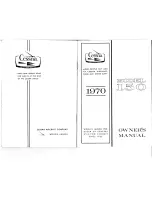
gliders for real pilots
independence
www.independence-world.com
gliders for real pilots
independence
www.independence-world.com
12
12
13
13.2. Big Ears:
The so called big ears is an easy, but not too efficient way to descend quickly, at which the forward-speed is
higher than the the sink-speed. It is more suitable to reduce the gliding-performance and to fly away from a
source of danger horizontally.
To do “big-ears” you simply pull down the outer part of the wing by pulling down the outer A-Risers (A´)
symmetrically.
Too severe pull down of both sides (by pulling down the next A-lines) reduces the speed but increases the risk of
a stall. Out of this reason always use only the outer A-rider (A´) to do big ears. By doing big ears you can
increase the descent to approx. 5m/sec and halve the gliding performance.
By using the speed-bar you can again increase the descent and forward-speed clearly.
To end big-ears you simply release the outer A-lines. The canopy of the Garuda normally re-opens by itself. To
make the reopen faster you can pull both brake-lines a little bit after releasing the A-lines.
Attention
:
Never attempt tight turns or spirals with Big Ears, as the A-lines will be over stressed.
13.3. B-line Stall:
The B-Stall with the Garuda is easy to enter. Both B-risers are pulled down slowly and symmetrically up to
20cm. The glider stalls and gets into a vertical descent flight.
To end the B-stall you simply release the risers within one second.
If the glider starts to turn during the B-stall or the wing-tips are moving forward you have to release the B-stall
immediately.
Possible reasons for turning or moving of the wing-tips could be:
turning: asymmetrical pulling of the B-riser, or one B- and one C-riser are pulled down.
frontal moving of the wing-tips (horseshoe): the B-risere are pulled down too far.
All descending manoeuvres shoulg be practised in calm air with enough safety height, that you are able to
control it perfectly then in cases of emergency!
Summary:
For all extrem flight and fast descening manoeuvres it´s important that you:
- train it first under instruction of a flying instructor or during a safety course.
- are sure that the air space under you is free before and while you are doing the flying manoeuvre.
- have a look on the canopy during the manoeuvre and also look on the distance to the ground.
14. Care, Storage, Repairs and Disposal of waste:
Your safety in the air depends on the condition of your paraglider. A maintained and properly used paraglider
will last a long time. In order to maintain your Garuda’s condition for a long time we
would like to give you the following advice:
Care:
!
In time the UV rays will damage the material of the paraglider. Therefore don´t leave the Garuda out in the sun
unnecessarily.
!
Take care that the paraglider will not get dirty while laying it out. The dirt particles can damage the material.
!
The line length should be checked after landing in a tree or in water.
!
Don´t pull around your glider while it is lying on the ground. This could damage the coating of the fabric.
!
Wetness damages the coating of the fabric and can reduce it´s lifespan.
!
If the lines get hung on the ground while staring the glider, they can be streched or can tear off.
!
Don´t step on the lines!
!
Put the cloth bag that comes with the glider underneath it when folding it up to ensure that the material of the
glider is not damaged.
!
Curl up the lines as little as possible with no sharp wrinkles.
!
If the glider gets contact with salt water clean it immediately with fresh water!
!
Insects in the cells should be removed alive, not just only for animal care reasons, but the insect secretion is
acid and can damage the fabric.
!
Clean your paraglider only with clean water and do not use brushes or hard rubbing. Chemical detergents will
damage the fabric and the lines.
Storage:
!
The glider must always be stored in dry condition. If the glider should have got wet, you have to spread it out to
dry it as soon as possible. (but do not lay it in the direct sunlight).
!
Do not store your paraglide near chemical fumes or gases.
!
Avoid unnecessary high temperatures during storage or during transport (especially in cars).
Repairs:
!
Small cuts in the material, if they are not along the seams, can be mended provisionally with special self-sticky
repair-tape which you get at paragliding specialized stores.
!
All other kinds of damages, like large cuts, cuts along the seam, ripped line loops, torn or damaged lines must
only be repaired by an authorized dealer or the manufacturer.
!
Use only original spare-parts!
!
Every alteration of the glider, unless authorised by the manufacturer, results in the glider´s certification
expiring.
!
The Garuda have to be checked by an authorized specialised company or the manufacturer at least after 300
operating hours or after 2 years.
Waste disposal:
!
The materials of which a paraglider is made require a special waste disposal. So please send disused gliders
back to us. We will care about an professional waste disposal.
15. Nature- and environment-friendly behaviour:
Actually it´s self-evident, but nevertheless mentioned particularly: Please do our nature-near sport in a way
which do not stress nature and environment!
Please do not walk beside the marked ways, don´t leave your litter, don´t make unnecessary loud noises and
respect the sensitive balance in the mountains.
Especially at the take-off we have to take care for the nature!


























